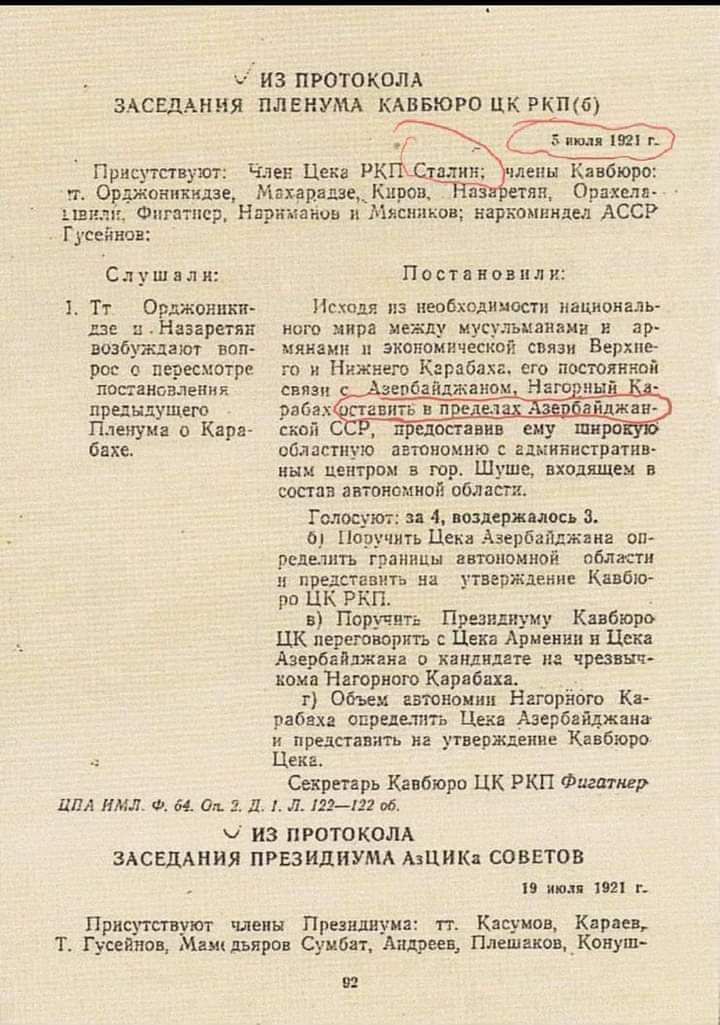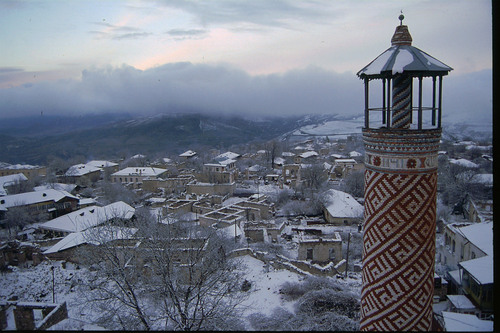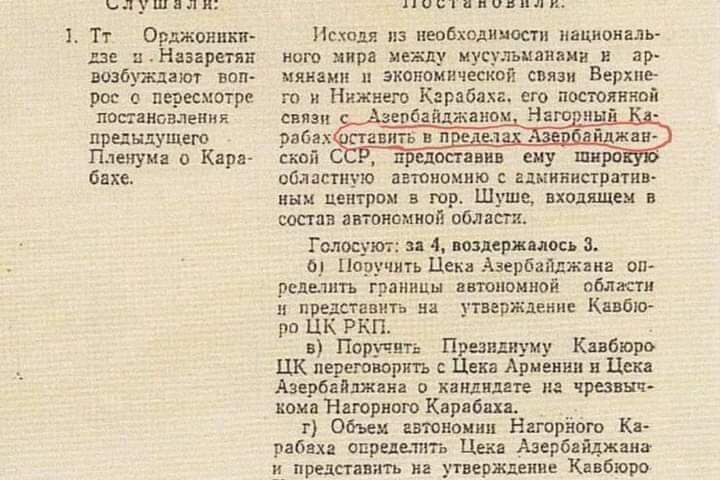The First Attempt to Join Nagorno-Karabakh to Armenia
In fact, the first step in this direction was made in the spring of 1921 when the government came up with a document of six points entitled The Basic Premises on Uniting Nagorno-Karabakh and the Republic of Armenia. It said that the mountainous part was separated from Lower Karabakh by a low mountain range.
Convinced that this mountain range should be joined to Nagorno-Karabakh, the Armenians argued that, first, this zone was allegedly used by the Armenians and, second, there were strips of arable land.
The Armenian government drew up a document which said that Nagorno-Karabakh (including the village communities of Talysh, Maragaly, Kasapet, Kabarek, Boyakhmedli, Khanabad, Gulabli, Engikend, Kagardin, and Qajar) should become part of Armenia. The authors had to admit that certain Muslim communities (Boyakhmedli, Gulabli, Qajar, and others) would remain part of Nagorno-Karabakh because certain Armenian areas would remain in the valley.
Art 5 of the document is especially interesting. It reads: “The transfer of Nagorno-Karabakh to the Republic of Armenia should be naturally accompanied by the transfer of so-called Kurdistan, a narrow mountainous strip between Karabakh and Zangezur. Its very specific location and the nationalist sentiments of its population, however, might cause certain problems. The following should be done to neutralize possible complications: this area is situated higher than the northern Shusha-Gerusi road and consists of six village communities with a total population of 27 thousand. This area can be transformed into a canton governed by the Republic of Armenia or, as a last resort, placed under Azerbaijan’s protectorate. Kurdistan might demand the Malybeyli community along with the town of Shusha. This cannot be done for the following reasons:
“1. The Malybeyli village is the only one with a settled population; it is practically non-existent: the people moved to the valley when Soviet power was established. Other villages are populated by nomads who settled on their land in the valley in the past few years.
“2. This community (Malybeyli.—J.H.) wedged between Varanda and Khachyn cannot form a unit. These two parts of the Shusha Uezd will remain divided, which means that no single administrative unit can be set up.
“3. This applies to the city of Shusha surrounded by the lands of the Shushikend community and the Armenian village of Gaybalikend. Historically, the area of the city of Shusha is part of the lands of the Shushikend community.
“4. Kurdistan is connected to the valley by the road going through Khankendi.”28
The sixth, concluding, article of the document states the true intentions of the Armenian government in clear terms: “The Kaladarasi and Jamilli communities with their predominantly Armenian population are found to the south of Kurdistan in the Akkara valley. This strip with a road offers the only connection between Zangezur and Nagorno-Karabakh as a future single administrative unit with a single administration. Without this, there is no sense in joining Nagorno-Karabakh to the Republic of Armenia.”29
In May 1921, the Armenian government, guided by the above and never bothering about the legal arguments, unilaterally decided to join Nagorno-Karabakh to Armenia. The plenary session of the C.C. of the Communist Party of Armenia held on 23 May, 1921 appointed A. Ionisyan as envoy of Armenia in Nagorno-Karabakh. He was summoned from Baku to Tiflis by a telegram to receive instructions from A. Bekzadyan.30
The same plenum discussed the revolutionary committee of the Alexandropol Uezd; D. Ter-Simonyan was appointed as commissar of the Daralagez Uezd. After listening to D. Pirumov, who informed the plenum about the statement of the Zangezur commission, the meeting ruled the following: “The note to Azerbaijan should be postponed until the Nagorno-Karabakh issue is clarified at the next plenary session of the Caucasian Bureau of the R.C.P. (B.).”31
In May, Armenia obviously took practical measures to join Nagorno-Karabakh and overcome Azerbaijan’s resistance. The so-called recommendations of the Caucasian Bureau and the decision of 3 June served the same purpose.
The Armenians were informed of the upcoming discussion of the problem at the June plenum of the Caucasian Bureau of the C.C. R.C.P. (B.), the decisions of which might have supplied the Armenians’ illegitimate actions with legal foundations.
In May 1921, the leaders of Azerbaijan carried out several organizational measures to forestall possible decisions on Karabakh. Armenak Karakozov, who from May 1920 to January 1921 filled a high post in the extraordinary commissariat of Zangezur and Karabakh, returned to Azerbaijan after serving for about twelve months in the Economic Council of Armenia. On 3 May, 1921, he was appointed as commissar extraordinary of Karabakh and Zangezur by a decree of the Azerbaijan Revolutionary Committee.32
A couple of weeks later, on 15 May, the Az.R.C. repealed its mandate of 3 May and moved Karakozov to the post of deputy commissar extraordinary of the Karabakh District. The same decree appointed N. Buniyatov as temporary commissar extraordinary of the Karabakh District.33
This reshuffling evidently happened because the Az.R.C. was reluctant to send A. Karakozov, particularly when vested with “extraordinary and unlimited powers,” to Karabakh, especially after Armenia declared this region “its inalienable part.” This reluctance was underpinned by N. Narimanov’s claim that Karakozov had “one foot in Armenia and the other in Azerbaijan,” thus casting aspersions on his loyalty.
Later Sergey Kirov (who in 1921 was placed at the head of the party organization of Azerbaijan) insisted on Karakozov’s appointment as a senior official in Karabakh. On 5 February, 1922, the joint meeting of the Politburo and Orgburo of the C.C. of the Communist Party of Azerbaijan passed the following decision: “To send Comrade Karakozov to Karabakh. Comrade Karakozov will receive the instructions related to his duties from the C.C. of the Communist Party of Azerbaijan.”
The decision of the joint meeting consisted of two parts; the second pointed out that Karakozov was delegated as a “representative of the Az.R.C. and the Armenian Revolutionary Committee and the C.C. Az.C.P. (B.).”34 Obviously, the C.C. Az.C.P. (B.) appointed Karakozov as a representative of both sides.







